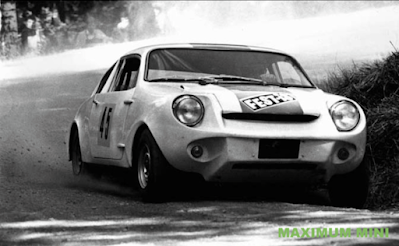Saturday, 22 April 2023
Having a break - back soon
Tuesday, 18 April 2023
Turner Ranger stars in James Bond movie
Thursday, 13 April 2023
The Targa Florio Mini Marcos (4)
Over to the 4th and (for now) final episode about the Mini Marcos that made it (briefly) to the 1967 Targa Florio (for part 1 click here, part 2 here, part 3 here)
Our Swedish Marcos-man Per Haegermark wrote earlier: "Before I can tell you with 100% certainty that #7034 is the Targa Florio car, I have to see one more document which I have ordered from the National Swedish Archives. They normally need three to four weeks to find the requested documents. Will get back to you a.s.a.p."
Well, the time has come for the document to arrive, so over to Per again: "Hi again Jeroen, Many thanks for the most interesting article you have compiled. Great job! Now, I think we are almost home. The final bits of the jigsaw puzzle come here now: I just received copies of the original registration document of #7034 from the National Registration Archives and I was very, very happy to see that the first owner of the car really was Jan-Eric Andreasson. Wow! The original registration number was 'AA 13515' and it was road registered for the first time on 19th October 1967 - that is after its racing career was ended. In the meantime I spent some time in picking out all racing and hillclimb entries of #7034 from my worldwide 'Historic Marcos Racing Records' database (more than 1500 entries between 1960 and 1975). Copy attached. I was very surprised to find only 10 entries out of which the car only managed to finish just one: the Röforsloppet Hill Climb driven by Börje Österberg."
"All other entries were either classed as 'Did not finish' or 'Did not arrive'. It seems that the car really would have needed a proper shake-down before entering the race tracks at all, wouldn't it? The reason for not having arrived at the Karlskoga and Skellefteå races was most probably that the team were putting it back in race trim after the crash at TF during the early stages of summer. For one reason or another they skipped Västkustloppet in favour of the Röforsloppet which both were arranged on the same day in August. The man behind the wheel was the most experienced driver Börje Österberg instead. The sticker on the bonnet says: 'Fest-Is' which was the most popular orange juice then and still is. It was not common with sponsorship in those days at all."
"Hope this mystery now has been resolved once and for all. It would be interesting to find out when and by whom the original engine was exchanged and when it changed colours etc. I believe it was green after its white/green era. Looking forward to hearing from you soon. Cheers for now, Per"
That is wonderful. Thank you very much for your enthusiasm Per.
Friday, 7 April 2023
Ogle now registered and ready for fun
About a year and a half ago I found this little Easter egg hidden in a Belgian barn for some 30 years (click!). Lots of work followed to get it going again but this week it was finally rewarded with a Dutch registration, all correctly as an Ogle SX1000, too. It seems likely to have been the only example sold new to Europe back in 1962, fact is it is the only one in The Netherlands now, causing the Dutch transport authorities a bit of a headache as they had never heard of an Ogle before. Anyway: it is road legal again after all these years of neglect. Now, let the sun shine! Have a good Easter.
Easter racing through the 1960s
Wednesday, 5 April 2023
Unravelling history - NJC Mini
It is one of my great frustrations when I can't quite find out the origins of a Mini based car. And the coachbuilt NJC Mini was a prime example. Who was behind it? How many did they build? Who did they sell their cars to? And what did the NJC name stand for in the first place? The only clue had been an article in Cars & Car Conversions magazine, but that mostly trumpeted over the car's appearance and build while it didn't say much about its origins.
But then I got in touch with Nick Cloot recently, who had in fact been one of the persons who built these cars back in the late 1970s. What's more: he was more than happy to tell the tale of how they came about. He thinks as many as 9 may have been built although not all of those have been accounted for as of yet. The NJC Minis had some fascinating details in- and outside, among these wheel arches hand made in steel and strong enough to jack up the car, Storno radiophones, airconditioning systems and - the piece-the-resistance - electronic dashboards. The first of them was sold to a Lebanese businessman for use in central London, with more to follow.
I'd photographed a car years ago, which now seems to be the sole survivor (unless you know better). Together with all the information from Nick and some historical material he'd kept, the full story of the NJC Minis is now published in MiniWorld magazine's May issue. Oh - and we now know what NJC stands for, too! It's for Nick and John Costalas, who were the car's instigators.



























